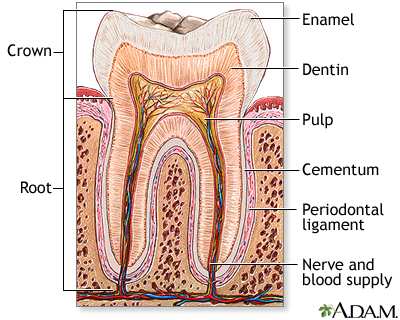Tooth formation - delayed or absent
Definition
When a person's teeth grow in, they may be delayed or not occur at all.
Alternative Names
Delayed or absent tooth formation; Teeth - delayed or absent formation; Oligodontia; Anodontia; Hypodontia; Delayed dental development; Delayed tooth eruption; Late tooth eruption; Delayed dental eruption; Congenitally missing tooth
Considerations
The age at which a tooth comes in varies. Most infants get their first tooth between 4 and 8 months, but it may be earlier or later.
Causes
Specific diseases can affect tooth shape, tooth color, when they grow in, or tooth absence. Delayed or absent tooth formation can result from many different conditions, including:
When to Contact a Medical Professional
Talk to your health care provider if your child has not developed any teeth by 9 months of age.
What to Expect at Your Office Visit
The provider will perform a physical exam. This will include a detailed look at your child's mouth and gums. You will be asked questions such as:
- In what order did the teeth emerge?
- At what age did other family members develop teeth?
- Are any other family members missing teeth that never "came in"?
- What other symptoms are present?
An infant with delayed or absent tooth formation may have other symptoms and signs that indicate a specific medical condition.
Medical tests are not often needed. Most of the time, delayed tooth formation is normal. Dental x-rays may be done.
Sometimes, children or adults are missing teeth they never developed. Cosmetic or orthodontic dentistry can correct this problem.
Gallery



References
Dhar V. Development and developmental anomalies of the teeth. In: Kliegman RM, St. Geme JW, Blum NJ, Shah SS, Tasker RC, Wilson KM, eds. Nelson Textbook of Pediatrics. 21st ed. Philadelphia, PA: Elsevier; 2020:chap 333.
Dinneen L, Slovis TL. The mandible. In: Coley BD, ed. Caffey's Pediatric Diagnostic Imaging. 13th ed. Philadelphia, PA: Elsevier; 2019:chap 22.
Turner EG, Dean JA. Eruption of the teeth: local, systemic, and congenital factors that influence the process. In: Dean JA, ed. McDonald and Avery's Dentistry for the Child and Adolescent. 11th ed. St Louis, MO: Elsevier; 2022:chap 20.